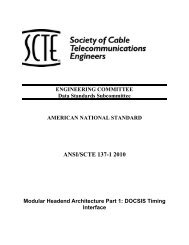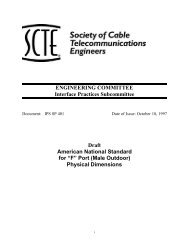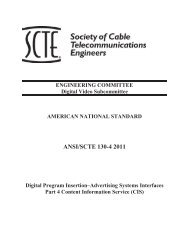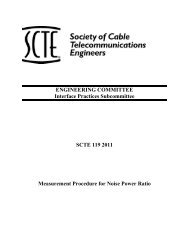You also want an ePaper? Increase the reach of your titles
YUMPU automatically turns print PDFs into web optimized ePapers that Google loves.
shall be coded per the frame_rate_code value from Table 6-4 in ISO/IEC 13818-2 [2] that<br />
matches the coded frame rate listed in Table 11 of <strong>SCTE</strong> 128 [4].<br />
Table 8-18 Frame Rate Codes (Informative)<br />
Frame Rate (Hz) frame_rate_code AVC time_scale AVC num_units_in_tick<br />
24/1.001<br />
‘0001’ 48000 1001<br />
(23.976...)<br />
24 ‘0010’ 48 1<br />
<strong>30</strong>/1.001 (29.97...) ‘0100’ 60000 1001<br />
<strong>30</strong> ‘0101’ 60 1<br />
60/1.001 (59.94...) ‘0111’ 120000 1001<br />
60 ‘1000’ 120 1<br />
progressive_sequence – For MPEG-2 video, this parameter shall be coded per Section<br />
6.3.5 in ISO/IEC 13818-2. For AVC video, this parameter shall be set to ‘1’ when the<br />
letter ‘P’ in Table 11 of <strong>SCTE</strong> 128 [4] is listed with the corresponding frame rate;<br />
otherwise, this parameter shall be set to ‘0’.<br />
9. Time Synchronization<br />
Time synchronization is required due to the communication of time between the Server and<br />
the Splicer. The delay on a TCP/IP message is somewhat unpredictable and is affected by<br />
other machines on the network. By having the machines synchronized, time can be<br />
communicated between the two machines without concern for normal network delays<br />
keeping the splicing very accurate. One possible method is to use Network Time Protocol<br />
(NTP) to keep the Server and the Splicer in synchronization. It is likely that Servers already<br />
keep some time synchronization, and thus could provide the NTP service and the Splicer<br />
could be an NTP client. A network common host system NTP server could also be used since<br />
this also typically exists in a cable headend that has a network infrastructure.<br />
The time synchronization system must be able to keep the Splicer and Server within +/- 15<br />
ms of each other. The system may use the Alive_Request/Alive_Response messages to<br />
detect if the two devices have proper synchronization and to alert the operator if<br />
synchronization is lost.<br />
The bit stream representing the primary channel is subject to various delays, which may<br />
include upstream splicing, satellite links, and other transmission and conditioning processes.<br />
These delays may total from milliseconds to seconds. However, these delays do not affect<br />
the accuracy of a cue message embedded in the primary channel. The cue message uses the<br />
43

















